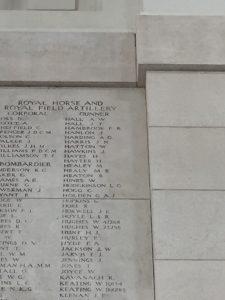Today we commemorate the 100th Anniversary of the death of Billingborough man Leslie Grosvenor Hodgkinson, killed in action 28th July 1917.
Leslie was born in early 1894 in Billingborough the eldest of three sons born to Charles Grosvenor Hodgkinson, a Journalist born in Grantham and his wife Mary Ann Burrows of Swinsted.
His two brothers Charles Norman, 1895 and Thomas Basil, 1897 were also born in Billingborough. Their parents had married in the Nottingham area in 1893.
The young family made their home on the High Street in Billingborough as can be seen in the 1901 census although by 1911 Leslie was working as an insurance clerk and living at 14 Mansfield Grove, Nottingham and lodging with Fanny Nelson.
The young men of Billingborough were quick to answer their call and the Grantham Journal carried an article on the 12th September 1914 naming the “Local Patriots”
“Several Billingborough and Horbling young men have rallied most patriotically to the nation’s call. Their names and the regiments in which they have enlisted are as follows:-H.J. Tebb, Royal Horse Artillery, R,W Tebb, Royal Horse Artillery and Herbert Tebb, 11th Hussars, sons of Mr. H. Tebb (Horbling); Leslie G Hodgkinson, Royal Field Artillery and C Norman Hodgkingson, Royal Engineers, sons of Mr. C.G. Hodgkinson; Ernest Smith, Royal Field Artillery and Albert Smith, Oxford and Bucks Light Infantry, sons of Mr. William Smith, Bootmaker. Mr Smith has also another son in the regular service, viz., Bandman Archie Smith, 3rd King’s Royal Rifles. The following have enlisted in Lord Kitchener’s New Army: – Fred Harrison, son of Mr. H.C. Harrison; Walter Nicholson, W. Carpenter (Horbling), Frank Corn, W. Watson (Horbling), Harris Ellingworth (Horbling), W. Swin (Horbling), H. Kemp (G.N. railway clerk, Billingborough), W. Birch and W.H. and J.F. Pattinson (Stow). Mr. John Marshall, hairdresser, who saw active service in the South African war, has also been accepted. The Yeomanry ranks include Eric Barber, son of All. J.S. Barber, of Rookfield. There are several others serving in the Regular Army. The recruits mentioned are in addition to the lads – mostly farm hands – who enlisted on Monday night.”
A further article on the 24th of December 1914 mentioned Leslie Hodgkinson as one of the lads that had recently been home for short leave.
Leslie was posted to “B” Battery of the 58th Brigade Royal Field Artillery and sailed with them and on the 9th August they landed at Anzac Cove in Galipoli. A week later it was moved to the Left Flank Artillery in the Suvla Bay area and came under temporary command of the 10th (Irish) Division.
Leslie wrote a letter home that was edited into an article by the Grantham Journal on the 21st August under the headline “Sunshine and Flies”
Writing from “Somewhere with the British Mediterranean Expeditionary Force” Bombardier Leslie G Hodgkinson, of the R.F.A. gives some interesting particulars of the difficulties encountered by the troops. He says their greatest troubles are the intense heat and the pestering habit of the flies. There is one continuous blaze of sunshine from the rising to the setting of the orb, and the hottest days in England are not in it with the heat out there. there are myriads of flies, covering their food every time it is served, and pestering them at all times, more especially when they want to snatch a few hours’ sleep. The sand blows about in blinding clouds, covering everything and they must have eaten quite a lot with their food. Although we, in England, have been having record rains this summer, they have not seen a spot since they left England at the beginning of July. In spite of the discomforts, the general health of the troops is good, and a fine spirit of courage and determination pervades the lot of them.
The Brigade remained in Galipoli until the 18th December 1915 and sailed for Alexandria, Egypt, arriving there on the 2nd January 1916. They stayed in Egypt for 6 months, a regular story for many of the ex Galipoli brigades, before being posted to France in preparation for the Somme offensive.
Leslie is next mentioned in another Grantham Journal article on the 23rd June 1917.
“ON LEAVE- Mr. C. G. Hodgkinson’s eldest son, Leslie who is in the R.F.A. has returned home this week for his first leave, after being abroad for two years. After going through the Gallipoli campaign, he was sent to Egypt for six months, prior to being transferred to France, where he has been fighting since June 1916. His battery was engaged in all the big battles on the Somme and although he saw severe fighting at Arras, La Boisselle, Pozieres, Thiepval, Courcellette, Le Says, Bapaume and Bullecourt, his worst experiences were in the Ypres Sector. With his Artillery officer, he went over the top with the infantry and tells some thrilling accounts of what he saw after the explosion of the mines. In spite of the long and arduous work he had had to perform and the privations and hardships suffered on the Gallipoli Peninsula , he looks very little the worse for his experiences.”
Leslie rejoined his battery in the Ypres Salient immediately after his leave, although his return was short lived as less than a month later he would be killed in action just days before the battle of Passchendaele (3rd Battle of Ypres) commenced.
In memory of Gunner Leslie Grosvenor Hodgkinson (20981)
“B” Bty, 58th Bde, Royal Field Artillery who died on 28 July 1917 Age 23
Son of Charles Grosvenor Hodgkinson and Mary A Hodgkinson, of Billingborough, Lincs
Remembered with honour, Ypres (Menin Gate) Memorial.
We were very honoured to be in Ypres on the 100th anniversary of Leslie’s death and were pleased that we could pay our respects on this sad anniversary.




Recent Comments